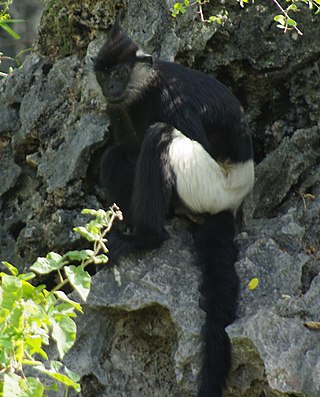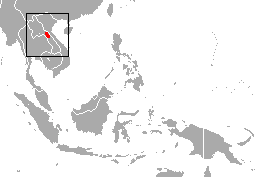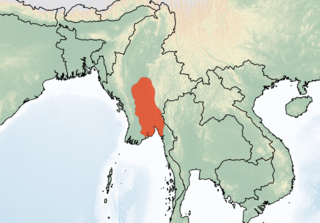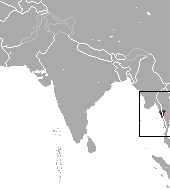
Trachypithecus is a genus of Old World monkeys containing species known as lutungs, langurs, or leaf monkeys. Their range is much of Southeast Asia.

The Hatinh langur is a highly threatened Old World monkey found in limestone forests in Vietnam, primarily in the Quảng Bình Province. A recent survey discovered a small population living in the Quảng Trị Province. Contrary to its name, it is not known from the Hà Tĩnh Province. The local Van Kieu minority refer to this monkey as the 'Con Cung', which roughly translates as "black, cliff-dwelling monkey with a long tail". It resembles the closely related François' langur, but its white cheek-stripes typically extend behind the ears onto the nape, and the overall black colour is non-glossy and has a brownish tinge.

The silvery lutung, also known as the silvered leaf monkey or the silvery langur, is an Old World monkey. It is arboreal, living in coastal, mangrove, and riverine forests in Peninsular Malaysia, Sumatra, Borneo, Java, and other nearby islands.

The East Javan langur, also known as the ebony lutung, Javan langur or Javan lutung, is an Old World monkey from the Colobinae subfamily. It is most commonly glossy black with a brownish tinge to its legs, sides, and "sideburns". It is found on the island of Java, as well as on several of the surrounding Indonesian islands. The Latin word auratus in its scientific name means "golden", and refers to a less common color variant. Note that the common name golden langur is used for a different species.

Delacour's langur or Delacour's lutung is a critically endangered species of Old World monkey endemic to northern Vietnam. It is named for French-American ornithologist Jean Théodore Delacour.

The Cat Ba langur, also known as the golden-headed langur, is a critically endangered species of langur endemic to Cát Bà Island, Vietnam. It is among the rarest primates in the world, and possibly the rarest primate in Asia, with population size estimated at less than 70 individuals.

The Laotian langur or white-browed black langur is a species of primate in the family Cercopithecidae. It is endemic to Laos. Its natural habitat is subtropical or tropical dry forests. Genetically the Indochinese black and Hatinh langurs are very close to the Laotian langur, and consequently it has been suggested they should be considered subspecies of it.

The capped langur is a species of primate in the family Cercopithecidae. It is native to Bangladesh, Bhutan, India, and Myanmar. Its natural habitat is subtropical or tropical dry forests. It is threatened by habitat loss. They are arboreal and gregarious by nature. A herd of capped langurs consists of 2 to 14 langurs led by a single male. They are herbivorous, eating leaves, twigs, buds and fruits.

Germain's langur is a Old World monkey native to Thailand, Myanmar, Cambodia, Laos and Vietnam. The monkey was previously included in Trachypithecus cristatus and Trachypithecus villosus.
The Indochinese black langur is a poorly known Old World monkey native to Laos and adjacent Vietnam. It was originally described as a subspecies of T. auratus, but was later found to be a member of the T. francoisi group, with some maintaining it as a subspecies of that species. In 2001, it was recommended treating it as a separate species.

The Selangor silvered langur is a species of leaf monkey found on the west coast of Peninsular Malaysia. It had been previously considered a form of silvery lutung. Roos and colleagues elevated this population to a subspecies level, Trachypithecus cristatus selangorensis, in 2008. It has since come to be regarded by primatologists as a separate species, Trachypithecus selangorensis.

The West Javan langur is an Old World monkey from the Colobinae subfamily. It was formerly considered a subspecies of Trachypithecus auratus until it was elevated to a separate species by Roos and Groves. It is listed as vulnerable by the IUCN. Its range is restricted to the island of Java west of Jakarta. Its range is currently restricted to Ujung Kulon National Park, Muara Angke Wildlife Reserve and Muara Gembong due to industrial development, habitat fragmentation and the disconnection of protected areas. They are known to eat the leaves and fruits of Sonneratia in mangroves.

The Annamese langur is an Old World monkey from the Colobinae subfamily. It was formerly considered a subspecies of Trachypithecus germaini until it was elevated to a separate species by Roos and Groves in 2008. Its fur is lighter in colour than that of Trachypithecus germaini. Its range includes parts of Cambodia, Laos and Vietnam.

The Popa langur is a species of primate in the family Cercopithecidae. It occurs only in Myanmar and was named after Mount Popa, where a population of 100 of the monkeys live. It is listed as Critically Endangered on the IUCN Red List, as the wild population is thought to comprise 200 to 250 mature individuals.
The Shan State langur is a subspecies of primate in the family Cercopithecidae. It is found in eastern Myanmar and southwest China. While it is typically considered a subspecies or even a synonym of Phayre's leaf monkey, it is sometimes listed as a full species.

The white-headed langur is a Critically Endangered species of langur endemic to Guangxi, China.

The Indochinese grey langur is a species of Old World monkey native to East and Southeast Asia.

















